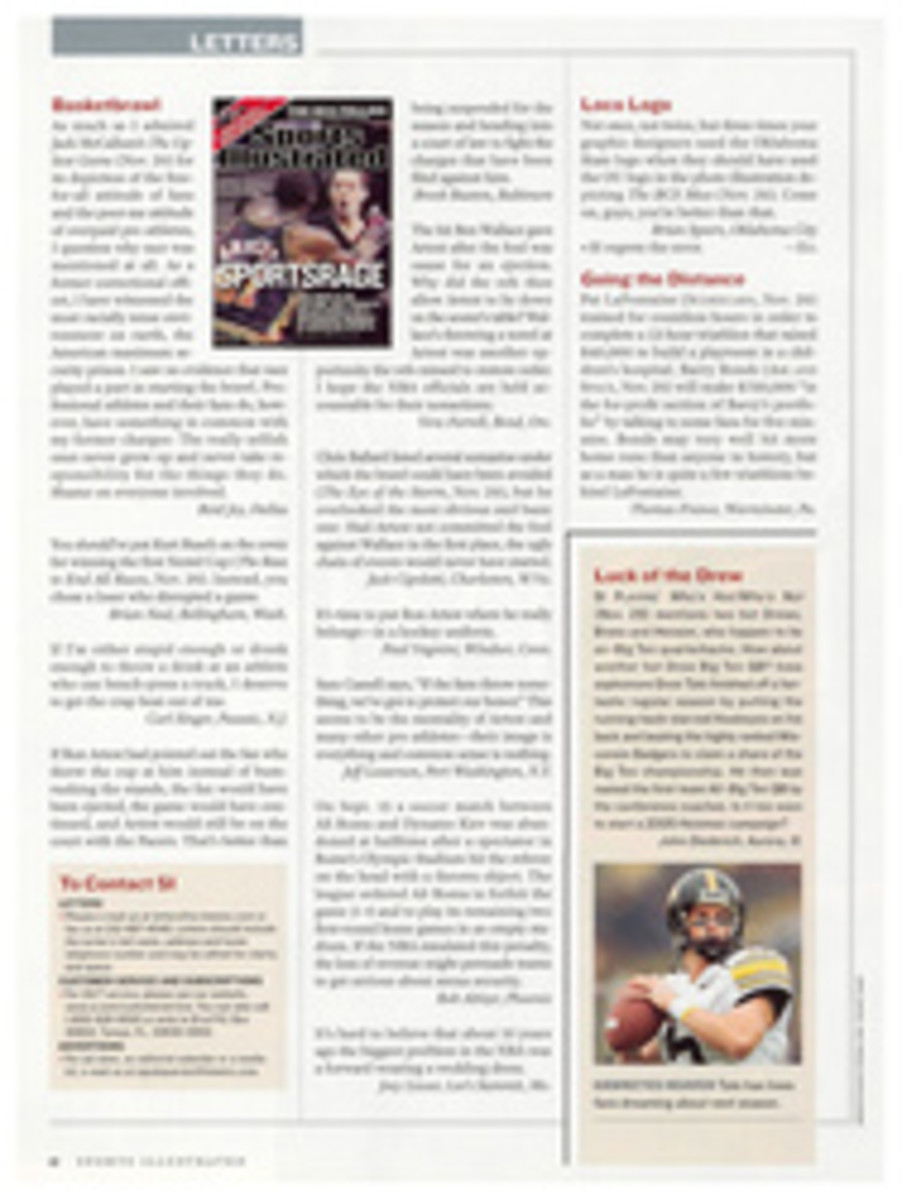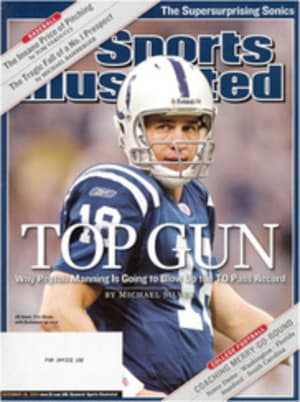
Is This Guy Worth $33 Million?
With surging attendance, rising television ratings, a continuing ballpark construction boom and strong teams in the megamarkets of New York City, Boston, Chicago and Los Angeles, baseball can boast of vigorous health. The most telling vital sign, however, was evident at the winter meetings last week in Anaheim: The outrageous contract is back. ¶ After the two fiscally cautious winters that followed the 2002 labor deal and came to be known as a "market correction," baseball teams enriched free agents and enraged one another with a return to the sort of payouts that not too long ago put players in the company of megaconglomerate CEOs. And it did not take free-agent stars such as centerfielder Carlos Beltran, righthander Pedro Martinez and third baseman Adrian Beltre (all still unsigned at the close of the meetings on Monday) to make clubs open the spending spigot. No, the market for second-tier starting pitchers inspired the new largesse (winning records not required).
Righthanders Kris Benson (career won-lost: 47--53), Matt Clement (69--75) and Carl Pavano (57--58) all drew multiyear bids for at least $7 million a year, as did a trio of starters with plump career ERAs: Jaret Wright (5.09), Eric Milton (4.76) and Jon Lieber (4.20). But it was righthander Russ Ortiz (103--60, 4.00), a plow horse of a pitcher, who signed what one American League executive called "the worst contract of the winter--so far": a four-year, $33 million deal with the Arizona Diamondbacks after his former team, the Atlanta Braves, showed no interest in retaining him. Those not-so-magnificent seven starters have four All-Star selections combined, and none has more than one.
With 155 free agents still available, Ortiz, 30, became the fourth player this off-season to sign a contract for more than three years. That's one more such deal than was signed all of last winter, when only proven pitchers Bartolo Colon and Keith Foulke and superstar outfielder Vladimir Guerrero drew that kind of commitment. To the anger of Major League Baseball officials, the infamously cash-strapped Diamondbacks shelled out $78 million in two days with four-year deals for Ortiz and third baseman Troy Glaus, accounting for two of the four long-term investments. The other two players to go deep on contract duration were Pavano, who on Monday was finalizing a four-year deal with the New York Yankees for about $40 million, and shortstop Cristian Guzman (four years, $16.8 million from the Washington Nationals), on whom the Minnesota Twins had declined a $5.25 million option.
"Two years ago," says agent Scott Boras, "Kenny Rogers went on the market after winning 13 games and wound up signing in March with Minnesota for one year and $2 million. Now the equivalent of Kenny Rogers is Eric Milton." The lefthanded Milton, 14--6 for the Philadelphia Phillies, is reportedly seeking a three-year deal worth $24 million.
So what gives--other than a G.M. with a hole in his rotation? The game is awash in new revenue generated since the groundbreaking '02 collective bargaining agreement, including money from satellite radio, international broadcasting and Internet services, all of which is split equally among the clubs. Moreover, that labor deal created the game's most extensive revenue-sharing system, spreading money and optimism to even the most feeble franchises.
"It's been kind of a perfect storm," says one American League G.M. "You've got increased revenues, you've got a few teams with money to spend that didn't have it before, and you've got the Benson contract."
The Benson contract is recognized as the starting point for this new era of splurging, the welcome to fat citysign. In his five-year major league career, Benson, 30, has had one winning season and one with an ERA lower than 4.00--and they weren't in the same year. He has never made an AllStar team or won more than 11 games. He has completed only five of his 137 career starts (as many as the underwhelming Cory Lidle finished last year alone). The New York Mets, however, re-signed him to an industry-rattling three-year, $22.5 million contract.
The reverberations were felt immediately. The Yankees, who had declined an $8 million option on Lieber and estimated the righthander's annual value at around $6 million, virtually lost interest in re-signing him; the Phillies landed Lieber for $21 million over three years. Then the Yankees, seeking to inject youth and power into their rotation, gave a similar deal to the hard-throwing Wright, 28, an injury-plagued righthander who has never logged 200 innings in a season, before trying to nail down a deal with Pavano, 28.
Clement, who has been more durable and efficient than Benson, is next in line to benefit from the Benson Effect; Anaheim, Arizona, Seattle, Cleveland and Toronto are all courting him with three-year deals that could pay more than $24 million. Righthander Derek Lowe, unwanted by the world champion Boston Red Sox after he had a 5.42 ERA last season, is yet another free agent who figures to owe Benson and the Mets a thank-you note. He has drawn interest from several teams, including Detroit and Baltimore.
"The story of the meetings is the price of pitching," Jeffrey Lane, the agent for shortstop Edgar Renteria, said on Sunday as he waited in a hotel lobby for his cellphone to ring. Of the first 11 free agents to agree to contracts worth $7 million or more annually, eight were pitchers. And that didn't include the two-year, $8 million package that Boston gave 41-year-old lefty David Wells (12--8, 3.73 ERA, 1952/3 innings with the San Diego Padres last year); with incentives the contract ultimately could be worth $18 million. To boot, as the meetings broke up, the Mets were close to signing Martinez, having reportedly offered a four-year deal worth more than $50 million.
Yet no team had raised more eyebrows at the meetings than Arizona. The Diamondbacks figured to be a nonplayer in the free-agent market because they carried $175 million in deferred-salary debt. The contracts they gave Glaus and Ortiz stunned officials in the commissioner's office. Said one source there, who noted that the players' association should be worried about the club's ability to meet its payroll, "They've been lying to us."
Meanwhile, the Diamondbacks haven't ruled out trading their ace, lefthander Randy Johnson, to the Yankees or to another contender. Talks with New York broke off last month because of what the Yankees thought were unreasonable demands by Arizona. Johnson is due $17 million in 2005, the final year of his contract, and cannot be traded without his permission. (Johnson is also owed more than a whopping $60 million in deferred money.) Diamondbacks general partner Ken Kendrick said on Friday, "As of the moment Randy will be taking the mound for the Diamondbacks next spring." Asked if he knew whether Johnson wanted to remain in Arizona, Kendrick smiled and said, "Randy is an interesting guy. It depends on what moment you talk to him."
Like Johnson, Tim Hudson of the Oakland A's and A.J. Burnett of the Florida Marlins will be eligible for free agency after next season, and they too were the subject of trade talks at the meetings. After all, the price of retaining an ace is another bit of fallout from the inflationary market for second-tier pitchers. Says Boras, "If you can last long enough, it's a great place to get to: free agency as a pitcher."
Are Any of These Guys Worth It?
2005: DIAMONDBACKS
RUSS ORTIZ: four years, $33 million
Age: 30, career: 103--60, 4.00 ERA
2005: PHILLIES
JON LIEBER: three years, $21 million
Age: 34, career: 100--91, 4.20 ERA
2005: METS
KRIS BENSON: three years, $22.5 million
Age: 30, career: 47--53, 4.28 ERA
2005: YANKEES
CARL PAVANO: four years, $40 million
Age: 28, career: 57--58, 4.21 ERA
Doping Out The Roster
As tougher drug testing looms, teams are evaluating players in a new light
THE HOTEL SUITES that were turned into war rooms by baseball clubs during the winter meetings were stocked with the usual supply of contract information, statistics and scouting reports. But a new category has been added to the means of evaluating players: possible steroid use. Team officials now consider how a stricter testing program for performance-enhancing drugs, which is expected to be in place by Opening Day, will affect acquisitions.
The general managers of two National League clubs say the possibility of steroid use is factored into their medical evaluation of a player. According to one G.M., "In the past you knew the issue was there, but you didn't have to deal with it [because there was no testing]. Now we're forced to deal with it."
Or as one American League scout puts it, "You have to think about whether the 40-home-run guy is really a 20-home-run guy."
Owners and players are negotiating a revision of the sport's much-maligned drug-testing program to include more unannounced tests, possibly even off-season tests. (Players currently are tested once during the season, not including a follow-up test five to seven days after the initial one.) A source close to those talks said the owners also will ask that the list of banned substances be expanded to include EPO and HGH as well as socalled "greenies" or "beans"--forms of amphetamines that players have been taking before games for at least five decades, which is why it's unlikely that the union would go that far.
Players "bean up" to enhance focus and alertness and to give their tired and sore bodies a jolt of energy. The pills are often taken with coffee or highly caffeinated energy drinks. The late third baseman Ken Caminiti told SI in 2002 that only "one or two guys" per team play without taking stimulants--a practice so rare that it is known among players as "playing naked."
"If they banned greenies, they'd have to shorten the season," says one AL manager. "Guys can't get through the grind of the season without them. It used to be just for the veterans. Now the young players take them too. That [ban] would affect many more players than [prohibiting] steroids."
COLOR PHOTO
Photograph by Chuck Solomon
POUND FOOLISH
One executive called Arizona's deal with Ortiz "the worst contract of the winter--so far."
COLOR PHOTO
JEFF ZELEVANSKY/ICON SMI
COLOR PHOTO
ROBERT BECK
COLOR PHOTO
JOHN BAZEMORE/AP
COLOR PHOTO
BRAD MANGIN
UP FOR BID
Martinez got an offer from the Red Sox and met with the Yankees, but the Mets pursued him most aggressively.

